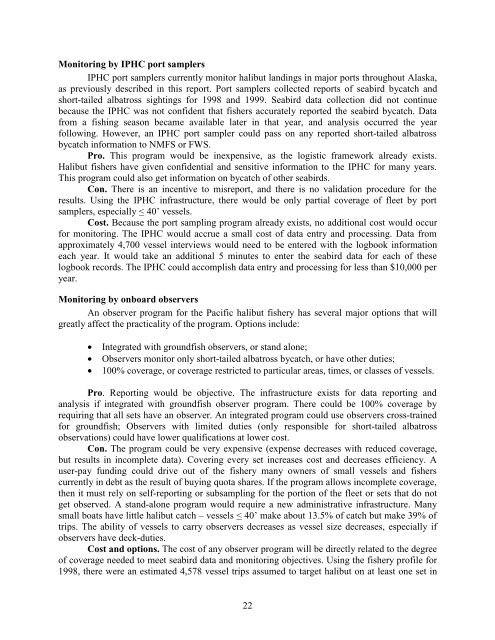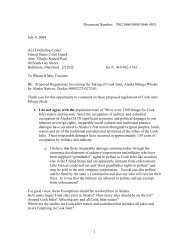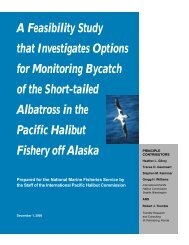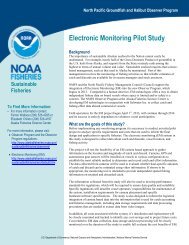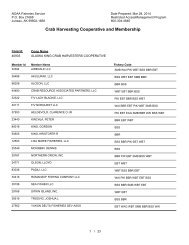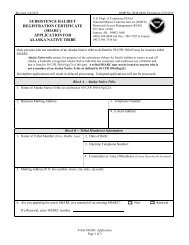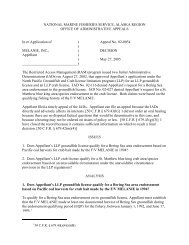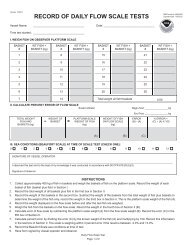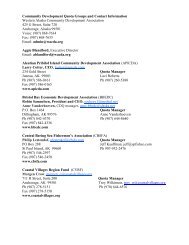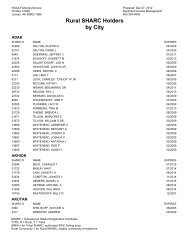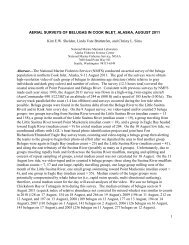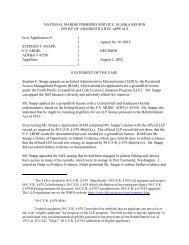Revised Report - National Marine Fisheries Service Alaska Region ...
Revised Report - National Marine Fisheries Service Alaska Region ...
Revised Report - National Marine Fisheries Service Alaska Region ...
You also want an ePaper? Increase the reach of your titles
YUMPU automatically turns print PDFs into web optimized ePapers that Google loves.
Monitoring by IPHC port samplersIPHC port samplers currently monitor halibut landings in major ports throughout <strong>Alaska</strong>,as previously described in this report. Port samplers collected reports of seabird bycatch andshort-tailed albatross sightings for 1998 and 1999. Seabird data collection did not continuebecause the IPHC was not confident that fishers accurately reported the seabird bycatch. Datafrom a fishing season became available later in that year, and analysis occurred the yearfollowing. However, an IPHC port sampler could pass on any reported short-tailed albatrossbycatch information to NMFS or FWS.Pro. This program would be inexpensive, as the logistic framework already exists.Halibut fishers have given confidential and sensitive information to the IPHC for many years.This program could also get information on bycatch of other seabirds.Con. There is an incentive to misreport, and there is no validation procedure for theresults. Using the IPHC infrastructure, there would be only partial coverage of fleet by portsamplers, especially < 40’ vessels.Cost. Because the port sampling program already exists, no additional cost would occurfor monitoring. The IPHC would accrue a small cost of data entry and processing. Data fromapproximately 4,700 vessel interviews would need to be entered with the logbook informationeach year. It would take an additional 5 minutes to enter the seabird data for each of theselogbook records. The IPHC could accomplish data entry and processing for less than $10,000 peryear.Monitoring by onboard observersAn observer program for the Pacific halibut fishery has several major options that willgreatly affect the practicality of the program. Options include:• Integrated with groundfish observers, or stand alone;• Observers monitor only short-tailed albatross bycatch, or have other duties;• 100% coverage, or coverage restricted to particular areas, times, or classes of vessels.Pro. <strong>Report</strong>ing would be objective. The infrastructure exists for data reporting andanalysis if integrated with groundfish observer program. There could be 100% coverage byrequiring that all sets have an observer. An integrated program could use observers cross-trainedfor groundfish; Observers with limited duties (only responsible for short-tailed albatrossobservations) could have lower qualifications at lower cost.Con. The program could be very expensive (expense decreases with reduced coverage,but results in incomplete data). Covering every set increases cost and decreases efficiency. Auser-pay funding could drive out of the fishery many owners of small vessels and fisherscurrently in debt as the result of buying quota shares. If the program allows incomplete coverage,then it must rely on self-reporting or subsampling for the portion of the fleet or sets that do notget observed. A stand-alone program would require a new administrative infrastructure. Manysmall boats have little halibut catch – vessels < 40’ make about 13.5% of catch but make 39% oftrips. The ability of vessels to carry observers decreases as vessel size decreases, especially ifobservers have deck-duties.Cost and options. The cost of any observer program will be directly related to the degreeof coverage needed to meet seabird data and monitoring objectives. Using the fishery profile for1998, there were an estimated 4,578 vessel trips assumed to target halibut on at least one set in22


